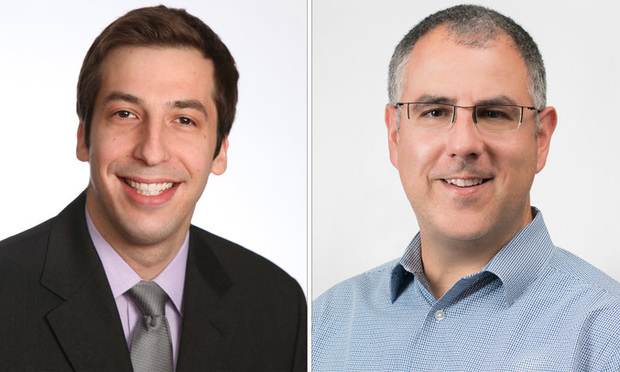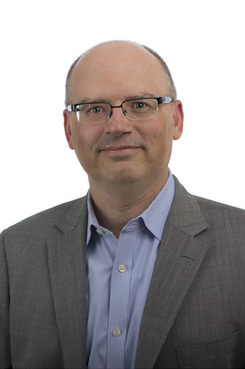Law Firm or Software Developer? Chapman and Cutler Is Now Both
The Am Law 200 firm, which recently sold a software application it developed in-house, says its approach to talent and innovation is paying off.
November 14, 2018 at 05:00 AM
10 minute read
 Eric Wood, left, and Michael Nogroski of Chapman and Cutler. Courtesy photos
Eric Wood, left, and Michael Nogroski of Chapman and Cutler. Courtesy photos
Eric Wood is the kind of lawyer Big Law firms often lose as a result of a character trait that firm management would love to cultivate: An entrepreneurial streak.
Chapman and Cutler almost lost him. About four years ago, Wood considered launching a legal tech startup that would take the pain out of a process that frustrated him as an associate: Creating closing document sets for financial transactions. The tedium of printing documents and arranging them in a room full of folders is not what attracted Wood to law school. It is, however, part of what inspired him to learn to code.
Last week, Chapman announced it had sold a software application, called Closing Room, that was developed inside the firm by Wood and the firm's practice and technology innovations team. The product, which was purchased by NetDocuments and will be available in early 2019, has been used to automate the paper- and people-heavy closing set process some 5,300 times at Chapman. It represents one of the first pieces of software to be developed inside a law firm and sold to a technology provider.
The terms of the sale were not disclosed, but Wood and Chapman will be involved in both integrating and marketing the product for NetDocuments.
“Many law firms are building interesting things internally,” Wood said. “But building something that has broader market appeal, that has been our biggest achievement to date for our group.”
How 225-lawyer Chapman kept Wood and built the Closing Room product is an example of a new, more flexible approach to both talent and law firm business that is likely to become increasingly important as technology intertwines with the practice of law. It is also a story about the importance of often-overlooked elements of driving change within a law firm: Leadership, working in a nonbillable hour structure and a focus on a specific practice area.
An Inauspicious Start
Wood has another unusual Big Law credential: He is an unsecured creditor of a bankrupt law firm.
After graduating from the University of Chicago Law School in 2008 and getting married, he moved to Seattle to work as an associate in the venture capital practice of Heller Ehrman. Two weeks later, the firm went under. A stipend Heller Ehrman had promised for his delayed start went unpaid, creating his unsecured claim.
 Chapman managing partner Tim Mohan
Chapman managing partner Tim MohanHe got back on his feet on the other side of the country as a New York City associate for Cleary Gottlieb Steen & Hamilton, where he'd interviewed as a 3L. The effect of bankruptcy lingered, though. Wood said it showed him that partners “are not infallible,” and it made him interested in the incentive structure of big law firms. He was curious why work was handled in ways that seemed to him to be inefficient and redundant.
“I got very bored doing the same thing over and over again,” Wood said. “I was frustrated that I had to do it. Frustrated that there wasn't a better way of doing it. Especially when I started out, I could not believe the normal way of practicing law existed.”
Looking for a way out of New York, he got in touch with a Chapman partner he had interviewed with years before. The firm had stuck out to him, in part, because it had a lower billable hour requirement than most other firms. He moved to Chicago in 2011 to work there.
'Embedded' Inefficiency
Wood became interested in knowledge management at Cleary, and he found a kindred spirit when Chapman hired Michael Dov Nogroski in 2013. Nogroski, who now serves as director of practice innovations at Chapman, had previously worked as a senior knowledge management analyst at Seyfarth Shaw.
The two began working together when Wood was a seventh-year associate, and they quickly had a list of innovative ideas to pursue. One was the use of document automation software that Thomson Reuters has since acquired, Contract Express, which the firm will use this year to automate the generation of more than 30,000 documents. According to Wood, who has coded more than 600 templates for automated documents, the firm is one of the heaviest users of the Thomson Reuters software. The firm has begun to sell that expertise directly to clients, giving them the ability to use the automated document templates.
Another idea Wood brought to Nogroski years ago was the product that went on to be sold last week as Closing Room.
“He showed me this notebook and I was like, 'Whoa,'” Nogroski said.
The process of creating closing sets of documents had frustrated Wood since his Cleary days. He still has a binder of closing documents in his office from a deal he handled in New York.
That binder represented an inefficient process for a portion of Cleary's work, but the problem was magnified at Chapman, which, as a firm, focuses exclusively on financing work. The firm handles thousands of closings a year. Conference rooms at its Chicago office have historically been filled for days or weeks on end with papers that administrative assistants, associates and even partners spend hours sorting into binders.
In materials alone—paper, printing services, CDs, shipping—Chapman figures the cost of producing a closing set ranges from $500 to $1,500. But of course, the real question is time. Simple closing sets can be assembled in a few hours. Others take more than 10 hours, Wood said. That used to be a moneymaker for law firms, but clients are increasingly unwilling to pay for the time spent creating documents after a deal has closed.
“All in all, it's one of those incredibly inefficient processes that is embedded into basically every firm,” Wood said. “And it doesn't help anybody. It doesn't help firms, because they're not able to bill for most of this anymore. And it certainly doesn't help for clients to wait two months post-closing to receive their materials.”
A Partnership Track
When Wood showed Nogroski the notebook of ideas, he also told him he was thinking of leaving the firm to pursue “Closing Room” as a business venture. Nogroski convinced him to speak with Timothy Mohan, the firm's managing partner, about pursuing his ideas at the firm. It was early 2014.
Instead of the basis for a new company, Closing Room became part of a pitch Wood made for a new position at the firm. Instead of billing hours, Wood would focus on creating products such as Closing Room that could make the firm more efficient. Wood said Mohan had signaled to the firm that he was interested in innovative approaches to the business of law. For instance, he had brought Indiana University Maurer School of Law professor Bill Henderson in to speak with the firm.
Wood said he thought Mohan would be an “ally,” but he was still surprised by the result of his meeting.
“I think the craziest part of all this was he was just like, 'Yeah. You should do that,'” Wood said. “And he called my partners who were giving me work and basically said, 'Don't give Eric work for now. We're going to see how he does on this stuff.'”
He added: “In terms of different paths I could have chosen, that was pretty optimal.”
Mohan said the partners he called were on board with the idea. Wood had already, on his own time, created demos of some automated tools. And a significant cohort of partners at Chapman had a need for what he wanted to do. They had, for a long time, Mohan said, viewed technology as a way to both do work more efficiently and to provide an aspect of quality control. That was partly because roughly 40 percent of the work Chapman handles is done on a nonhourly basis.
“They say I've got this huge practice, I have to get a ton of product out the door, and if I don't design a better workflow for this, I'm never going to go home or see my family,” Mohan said. “And so the incentives are aligned for them. … This was an incremental thing for them; not a revolutionary thing.”
For Wood, it turned out to be somewhat revolutionary. He was named a partner in April 2017. His title—practice innovations and technology partner—appears to be unique among Big Law firms. It's been years since he's billed an hour of his time to clients.
“I don't want to have any billable hours,” Wood said. “If we're selling automation work, we're not selling that based upon how long it took me to build it.”
A Singular Focus
One recurring joke among Chapman lawyers is to compare the firm to Taco Bell. That is a reference to the way in which Taco Bell creates new products by rearranging many of the same basic menu items of soft shell tortillas, meat and cheese.
Because of Chapman focus on finance (which happens to be the firm's slogan), its innovation efforts often benefit a wide swath of the firm's lawyers rather that particular practice groups. The asset securitization group needs closing sets in the same way the commercial lending group does, for instance. The Taco Bell reference, Mohan said, is a reminder that the firm is “basically in one business.”
The firm's next step is to see if it can sell the products it has developed to other law firms, clients or, like in the case of Closing Room, tech companies.
The firm has begun to sell some of its document automation solutions directly to clients, Wood and Mohan said. The practice innovations team has also developed a tool that it presented at the Corporate Legal Operations Consortium (CLOC) in the spring that helps automate the process of reviewing nondisclosure agreements. The firm is still discussing how or if it will sell that software, or if it will sell a nondisclosure agreement review service that uses the software and lower-cost lawyers.
But with the sale this week of Closing Room, Chapman's investment in its technology team, and Wood, has already accomplished one goal Mohan and Wood said they were pursuing in a meeting at their offices this spring: Selling a piece of software.
The questions become thornier from here.
At a partnership retreat earlier this year, the firm's partners mulled over a scenario: How could Chapman, if it wanted to, compete with tech startups who are able to offer equity to programmers? Mohan and Wood said the firm would likely set up a nonlaw firm subsidiary through which to sell software and share the upside with programmers on staff. Since the spring, the firm has engaged an accounting firm to advise it on the tax aspects of launching such a subsidiary. Wood said he could envision the subsidiary launching in the next year.
“I think we've gotten lucky building some of the stuff in-house so far,” Wood said at a product development meeting earlier this year. “But if we really wanted to go out and build stuff, we'd have to figure out a different way to share the upside.”
Mohan replied, “But to do that we'd have to see some success with the first things we're trying to sell.”
“Absolutely,” Wood said.
This content has been archived. It is available through our partners, LexisNexis® and Bloomberg Law.
To view this content, please continue to their sites.
Not a Lexis Subscriber?
Subscribe Now
Not a Bloomberg Law Subscriber?
Subscribe Now
NOT FOR REPRINT
© 2025 ALM Global, LLC, All Rights Reserved. Request academic re-use from www.copyright.com. All other uses, submit a request to [email protected]. For more information visit Asset & Logo Licensing.
You Might Like
View All

Trending Stories
Who Got The Work
J. Brugh Lower of Gibbons has entered an appearance for industrial equipment supplier Devco Corporation in a pending trademark infringement lawsuit. The suit, accusing the defendant of selling knock-off Graco products, was filed Dec. 18 in New Jersey District Court by Rivkin Radler on behalf of Graco Inc. and Graco Minnesota. The case, assigned to U.S. District Judge Zahid N. Quraishi, is 3:24-cv-11294, Graco Inc. et al v. Devco Corporation.
Who Got The Work
Rebecca Maller-Stein and Kent A. Yalowitz of Arnold & Porter Kaye Scholer have entered their appearances for Hanaco Venture Capital and its executives, Lior Prosor and David Frankel, in a pending securities lawsuit. The action, filed on Dec. 24 in New York Southern District Court by Zell, Aron & Co. on behalf of Goldeneye Advisors, accuses the defendants of negligently and fraudulently managing the plaintiff's $1 million investment. The case, assigned to U.S. District Judge Vernon S. Broderick, is 1:24-cv-09918, Goldeneye Advisors, LLC v. Hanaco Venture Capital, Ltd. et al.
Who Got The Work
Attorneys from A&O Shearman has stepped in as defense counsel for Toronto-Dominion Bank and other defendants in a pending securities class action. The suit, filed Dec. 11 in New York Southern District Court by Bleichmar Fonti & Auld, accuses the defendants of concealing the bank's 'pervasive' deficiencies in regards to its compliance with the Bank Secrecy Act and the quality of its anti-money laundering controls. The case, assigned to U.S. District Judge Arun Subramanian, is 1:24-cv-09445, Gonzalez v. The Toronto-Dominion Bank et al.
Who Got The Work
Crown Castle International, a Pennsylvania company providing shared communications infrastructure, has turned to Luke D. Wolf of Gordon Rees Scully Mansukhani to fend off a pending breach-of-contract lawsuit. The court action, filed Nov. 25 in Michigan Eastern District Court by Hooper Hathaway PC on behalf of The Town Residences LLC, accuses Crown Castle of failing to transfer approximately $30,000 in utility payments from T-Mobile in breach of a roof-top lease and assignment agreement. The case, assigned to U.S. District Judge Susan K. Declercq, is 2:24-cv-13131, The Town Residences LLC v. T-Mobile US, Inc. et al.
Who Got The Work
Wilfred P. Coronato and Daniel M. Schwartz of McCarter & English have stepped in as defense counsel to Electrolux Home Products Inc. in a pending product liability lawsuit. The court action, filed Nov. 26 in New York Eastern District Court by Poulos Lopiccolo PC and Nagel Rice LLP on behalf of David Stern, alleges that the defendant's refrigerators’ drawers and shelving repeatedly break and fall apart within months after purchase. The case, assigned to U.S. District Judge Joan M. Azrack, is 2:24-cv-08204, Stern v. Electrolux Home Products, Inc.
Featured Firms
Law Offices of Gary Martin Hays & Associates, P.C.
(470) 294-1674
Law Offices of Mark E. Salomone
(857) 444-6468
Smith & Hassler
(713) 739-1250











